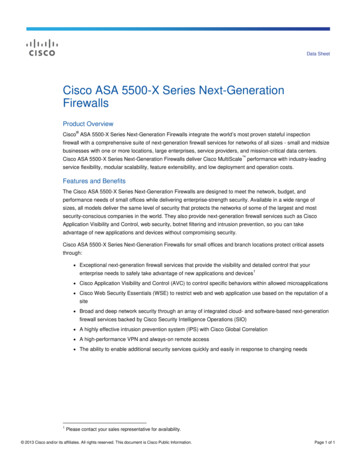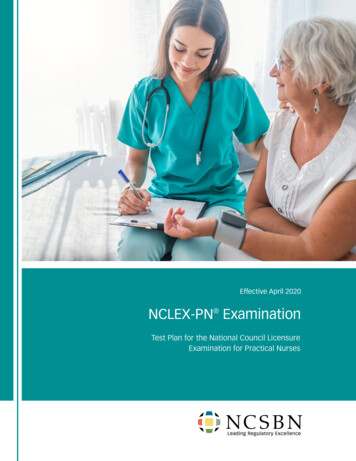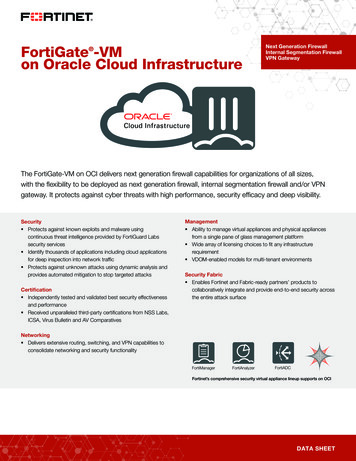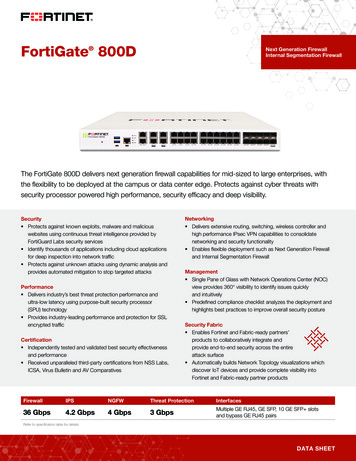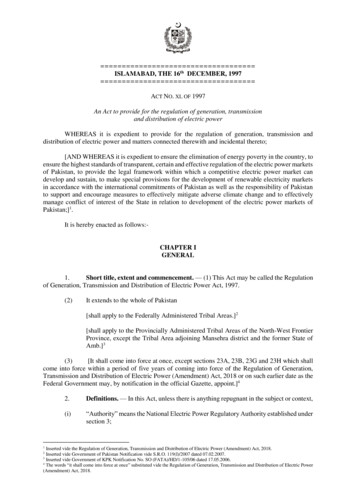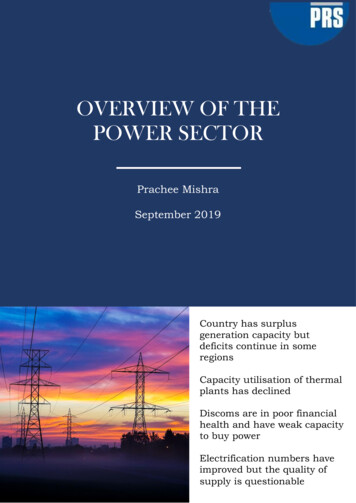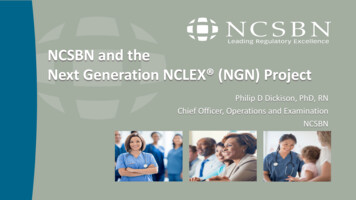
Transcription
NCSBN and theNext Generation NCLEX (NGN) ProjectPhilip D Dickison, PhD, RNChief Officer, Operations and ExaminationNCSBN
Objectives Discuss NCSBN Clinical Judgment research Define Clinical Judgment Model Review NGN item prototypes
Research and ClinicalJudgment MeasurementModel
Nursing and Clinical JudgmentIncreasingClientAcuityIncreasingClient AgeChanges inHealthCareIncreasedDemand forCompetentClinicalJudgmentKavanaugh and Szweda (2017) have identified a deficit in clinical judgmentexists with entry-level nurses.
The BeginningsNEC* 2012: Is theNCLEX measuringthe right things?*NCLEX Examination Committee2015: StrategicPractice AnalysisPilot Study
Literature Review Findings Education regarding critical thinking, clinical decision making, andclinical judgment has already become a standard part of nursingcurricula50%novice nursesinvolved innursing errors65%errorsattributed topoor clinicaldecision making Clinical judgment is important for public safety20%employers satisfiedwith clinical decisionmaking skills of novicenurses
Recent Evidence to Support NGN Research 20122015Functional Job Analysis(RNs)Strategic Job Analysis (RNs)2,522 SMEs24 Practice SettingsAll 4 Geographic Regions50 States and/or U.S.Territories Tenure ranges 0 – 45 years 90 SMEs20 Practice SettingsAll 4 Geographic Regions33 StatesTenure ranges 2 – 45 yearsTop 3 Areas Identified:1. Clinical Judgment2. Professional Communications3. Active Listening
SummaryClinical judgment is a necessary skill for the novice nurse.Client care and nurse errors can be improved by enhancing clinicaljudgment skills in novice nurses.There is a clear need for a direct, extensive, and explicitassessment of this construct in entry-level nurses.Assessing clinical judgment is a critical component of the overallgoal of NCLEX ascertaining minimum competency.Clinical judgment currently is indirectly tested in a limited mannerthrough integration across activity statements.
Development ofNCSBN Clinical Judgment MeasurementModel
Clinical Judgment Model FrameworksThree predominant nursing theoretical frameworks forassessing clinical judgment Intuitive-Humanistic Model (Benner) Dual Process Reasoning Theory/Model Information Processing ModelNursing clinical judgment is difficult to define.
Nursing Process ning
Clinical Judgment Model DefinitionJanuary 2015:Operational definition of nursing clinical judgmentClinical judgment is defined as theobserved outcome of critical thinkingand decision-making. It is an iterativeprocess that uses nursing knowledgeto observe and assess presentingsituations, identify a prioritized clientconcern, and generate the bestpossible evidence-based solutions inorder to deliver safe client care.
Focus is solely onmeasurement ofClinical Judgment Does not replacecurrent models ofteaching/learning Does not replaceNursing Process
NGN Measurement Model – Assessment FrameworkLayer 3 This layer provides the assessment elements that NGN clinical judgmentitems are written to address. For example, the NGN case study will include one item for each of the sixLayer 3 targets in the order shown Additionally, items are currently being researched that may map to morethan one target at a time—for example, a single item might map to both“Take Actions” and “Evaluate Outcomes.”
Definitions of Layer 3 Recognize Cues- Filtering information from different sources (e.g.,signs, symptoms, medical history) Analyze Cues- Linking the recognized cues to the client’s clinicalpresentation and establishing probable client needs, concerns, orproblems Prioritize Hypothesis- Evaluating and ranking hypotheses according topriority (urgency, likelihood, risk, difficulty, time, etc.) Generate Solutions- Identifying expected outcomes and usinghypotheses to define a set of interventions for the expected outcome Take Action- Implementing the solution(s) that addresses the highestpriorities; sometimes no action is an action itself Evaluate Outcomes- Comparing observed outcomes against expectedoutcomes
NGN Measurement Model – Assessment FrameworkLayer 4 This layer provides context for the clinical judgment items The white bubbles correspond to external factors such as the setting orresources available The gray bubbles correspond to internal factors such as the nurse’sknowledge and experience
Applying the CJ Task Model inEducation Cognitive Operations Layer 3 Factor Conditioning Layer 4 Expected behaviors/actions appropriate studentactions or observable outcomes The CJ Model assesses if a student is able to makean appropriate nursing clinical judgment by followingthe cognitive operations through an entire casestudy.
Cognitive FunctionRecognize CuesConditioning Factor(s)Environment Cues:Recognize abnormal vs normalPatient Observation Cues:Recognize signs and symptomsMedical Record Cues:Time Pressure Cues:Analyze CuesRequires knowledge of signs and symptoms of Prioritize HypothesisCan give vital signs as resourceCan add time pressure for context of vital signsGenerate SolutionsExpected BehaviorsIdentify history ofRequires prioritization of condition Address condition of Knowledge of conditionsKnowledge of treatment for conditions with nursinginterventionTake ActionsExperience:Nursing Intervention Evaluate OutcomesExperience:Follow-up on labs, vital signs, assessment etc- determineimprovement or worsening of condition being treatedPatient Observation Cue:
Next Generation NCLEX(NGN) Prototypes
NGN Case Study – What is it?The primary way the NGN will measure Clinical Judgment is throughthe use of case studies. Similar to “unfolding scenarios” common today in nursingeducation Body of information (“stimulus” or “scenario”) followed by sixrelated questions Each question tests an important element of clinical judgmentAs you review the sample provided, are you able to identify theconnections to real-world, safe and effective care?
NGN Case Study – Sample scenario Similar to Exhibits oncurrent RN and PNexams Presents informationabout client and setting May use single tab (e.g.,“Nurses’ Notes) ormultiple tabs
NGN Case Study – Sample item 1 of 6 Can students identify the most important information? Referred to as “Recognize Cues” in NCSBN Clinical Judgment Model
NGN Case Study – Sample item 2 of 6 Can students interpret the most important information? Referred to as “Analyze Cues” in NCSBN Clinical Judgment Model
NGN Case Study – Sample item 3 of 6 Can students synthesize important information to arrive at client needs? Referred to as “Prioritize Hypotheses” in NCSBN Clinical Judgment Model
NGN Case Study – Sample item 3 of 6 (continued) Can students synthesize important information to arrive at client needs? Referred to as “Prioritize Hypotheses” in NCSBN Clinical Judgment Model
NGN Case Study – Sample item 4 of 6 Can students develop possible care options aligned with client needs? Referred to as “Generate Solutions” in NCSBN Clinical Judgment Model
NGN Case Study – Sample item 5 of 6 Can students identify and perform the appropriate actions? Referred to as “Take Actions” in NCSBN Clinical Judgment Model
NGN Case Study – Sample item 6 of 6 Can students determine the effectiveness of interventions? Referred to as “Evaluate Outcomes” in NCSBN Clinical Judgment Model
NGN Case Study – Sample item 6 of 6 (continued) Can students determine the effectiveness of interventions? Referred to as “Evaluate Outcomes” in NCSBN Clinical Judgment Model
NGN Case Study – SummaryThe NGN Case Study presents students with a real-world nursingsituation and measures their ability to identify, analyze, andsynthesize the most relevant information into appropriate nursinginterventions that are prioritized based on client needs, selected andperformed correctly, and evaluated for effectiveness. Case studies will always include six items The order of the items will always match the order of this sampleset Some case studies will include multiple tabs of information in thestimulus
Clinical Judgment Measurement ModelThe NGN case studies and associated items reflect nursing situationssimilar to what students are already seeing in classrooms and willsee in clinical practice. However, it is not enough for the NGN toappear to measure important material. NCSBN has worked for morethan a decade to ensure the NGN provides an evidence-basedmeans of measuring clinical judgment in nursing.
More than a decade of research 2009 – NCSBN begins research onhow to measure clinical judgment innursing 2012 – Comprehensive literaturereview completed 2014 – Strategic job task analysis 2015 – Draft assessment frameworkdeveloped 2016 – Usability testing of new itemtypes 2017 – Optional research sectionadded to NCLEX-RN Today – Continuing research onmodel, item types, and scoring
Item Type Data Collection 884 NGN Items and 95 Forms have been deployed inITDC from July 2017 to December 2018 357,113 Candidates took NCLEX-RN exams and304,626 Candidates (85%) participated in ITDC fromJuly 2017 to December 2018 NGN participants spent about one minute on NGN Item
NGN ITDC Data Points1500000100000050000002017 Q32017 Q4Data Points2018 Q1Obtained Data Points2018 Q2
NGN Information on NCSBN Website
NGN ResourcesQuarterly lex.htmNext Generation NCLEX x.htmNGN Presentations & Talks:https://www.ncsbn.org/ngn-talks.htmNext Generation NCLEX FAQs:https://www.ncsbn.org/11449.htmMeasuring the Right Things, In Focus article:https://www.ncsbn.org/12021.htm
NCSBN Clinical Judgment ModelResearch and Task Model Publications Dickison, P., Luo, X., Kim, D., Woo, A., Muntean, W., & Bergstrom, B. (2016). Assessing higher-ordercognitive constructs by using an information-processing framework. Journal of Applied TestingTechnology, 17(1), 1-19. Retrieved /89187/67797. Dickison, P., Haerling, K., and Lasater, K. (2019). Integrating the National Council of State Boards ofNursing clinical judgement model into nursing. Journal of Nursing Education, 58(2), 72-78. Retrievedfrom https://doi.org/10.3928/01484834-20190122-03. Muntean, W. (2012). Nursing clinical decision-making: A literature review. Retrieved athttps://www.ncsbn.org/Nursing Clinical Decision Making A Literature Review.htm. Betts, J., Muntean, W., Kim, D., Jorion, N., Dickison, P. (2019). Building a Method for Writing ClinicalJudgment Items for Entry-Level Nursing Exams. Journal of Applied Testing Technology, Vol 20(S2), 2136, 2019.
Thank you!For additional information please email: nclexinfo@ncsbn.orgFor additional questions please email:nclexcontent@ncsbn.org
added to NCLEX-RN Today – Continuing research on model, item types, and scoring; Item Type Data Collection 884 NGN Items and 95 Forms have been deployed in ITDC from July 2017 to December 2

